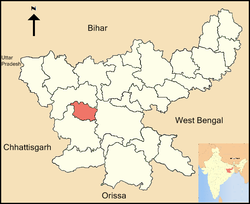| ||||||||||||||
| Lohardaga district लोहरदग्गा जिला |
|
|---|---|
| — District of Jharkhand — | |
| Location of Lohardaga district in Jharkhand | |
| Country | India |
| State | Jharkhand |
| Administrative division | South Chotanagpur division |
| Established | |
| Headquarters | Lohardaga |
| Government | |
| • Lok Sabha constituencies | Lohardaga (shared with Gumla district) |
| • Assembly seats | 1 |
| Area | |
| • Total | 1,490.80 km2 (575.60 sq mi) |
| Population (2001) | |
| • Total | 288,886 |
| • Density | 190/km2 (500/sq mi) |
| Demographics | |
| • Literacy | 53.97 per cent[1] |
| • Sex ratio | |
| Website | Official website |
Lohardaga district (Hindi: लोहरदग्गा जिला) is one of the twenty-four districts of the Indian state of Jharkand. The district is named after the town of Lohardaga, the administrative headquarters of the district. The district was created from a portion of Ranchi district in 1983.
The district is situated between 23°30' and 23°40' north latitudes and 84°40' and 84°50' east longitudes. The district covers an area of 1491 km².
As of 2011 it is the least populous district of Jharkhand (out of 24).[2]
It is currently a part of the Red Corridor.[3]
Economy[]
The inhabitants of this district mainly depend on agriculture, forest produce and seasonal migration to different parts of the country. 80% of the population depends upon agriculture. The main crop of this area is paddy. In the small irrigated area wheat is grown to meet the annual food sufficiency. Also this district is linked with larger vegetable markets like Jamshedpur, Rourkela and Calcutta. There is a cold storage in the district. But profitable vegetable cultivation is being limited to road side non-tribals. Generally, villagers of the district keep plough animals. Also they keep goats and poultry birds as buffer. Although there is a dairy chilling plant in the district head quarter, dairy is practised by very few people mainly non-tribal.
The net sown area is only 55% of the total area of the district. Two blocks i.e. Kisko & Senha have large area under dense forest cover. The forest cover is around 32-35% of the total area of the district. The average land holding per household is 1.65 Ha. The per capita agriculture land is around 0.28 Ha. Net irrigated area is 13.4% of net sown area (0.8% by canals, 7% by wells, 2% by tanks & 3.6% by lift irrigation & others).
Most of the villages except the hilly pockets of the district are connected with the roads. Still some of the hamlets have no linking roads. Electricity is supplied from Patratu Thermal Power Station which is in the Hazaribagh district. Out of 354 villages only 25 have rural electrification. Water supply system is not available in rural area. The villagers get their drinking water from tube wells and dug wells.
In 2006 the Indian government named Lohardaga one of the country's 250 most backward districts (out of a total of 640).[4] It is one of the 21 districts in Jharkhand currently receiving funds from the Backward Regions Grant Fund Programme (BRGF).[4]
Divisions[]
It has five blocks: Lohardaga, Kuru, Bhandra, Kisko and Senha. This district has a pace setting institution Jawahar Navodaya Vidyalaya Yojna in Senha block.
There are 353 villages spread over in 66 Gram Panchayats. Total number of household are 50,374 out of which 91% were in the rural areas (1991 census).
Demographics[]
According to the 2011 census Lohardaga district has a population of 461,738,[2] roughly equal to the nation of Suriname.[5] This gives it a ranking of 549th in India (out of a total of 640).[2] The district has a population density of 310 inhabitants per square kilometre (800 /sq mi) .[2] Its population growth rate over the decade 2001-2011 was 26.67 %.[2] Lohardaga has a sex ratio of 985 females for every 1000 males,[2] and a literacy rate of 68.29 %.[2]
Languages[]
Among the languages here is Asuri, an Austro-Asiatic language spoken by approximately 17 000.[6]
Education and health services[]
There are 318 primary schools, 68 middle schools, 20 High schools, 2 higher secondary schools and one college in the district. In this district, there is a district hospital, one referral hospital, five primary health sub-centres, ten additional primary health centres, seventy three health sub-centres.
References[]
- ^ "District-specific Literates and Literacy Rates, 2001". Registrar General, India, Ministry of Home Affairs. http://www.educationforallinindia.com/page157.html. Retrieved 2010-10-10.
- ^ a b c d e f g "District Census 2011". Census2011.co.in. 2011. http://www.census2011.co.in/district.php. Retrieved 2011-09-30.
- ^ "83 districts under the Security Related Expenditure Scheme". IntelliBriefs. 2009-12-11. http://intellibriefs.blogspot.com/2009/12/naxal-menace-83-districts-under.html. Retrieved 2011-09-17.
- ^ a b Ministry of Panchayati Raj (September 8, 2009). "A Note on the Backward Regions Grant Fund Programme". National Institute of Rural Development. http://www.nird.org.in/brgf/doc/brgf_BackgroundNote.pdf. Retrieved September 27, 2011.
- ^ US Directorate of Intelligence. "Country Comparison:Population". https://www.cia.gov/library/publications/the-world-factbook/rankorder/2119rank.html. Retrieved 2011-10-01. "Suriname 491,989 July 2011 est."
- ^ M. Paul Lewis, ed (2009). "Asuri: A language of India". Ethnologue: Languages of the World (16th edition ed.). Dallas, Texas: SIL International. http://www.ethnologue.com/show_language.asp?code=asr. Retrieved 2011-09-28.
External links[]

|
Latehar district | 
| ||
| Ranchi district | ||||
 Lohardaga district | ||||
| Gumla district |
| |||||||||||||||||
Template:South Chotanagpur Division Template:South Chotanagpur Division topics
| This page uses content from the English language Wikipedia. The original content was at Lohardaga district. The list of authors can be seen in the page history. As with this Familypedia wiki, the content of Wikipedia is available under the Creative Commons License. |
